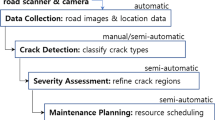Abstract
Road pavements require periodic maintenance and repair, which as a national infrastructure facility requires an enormous annual. The crack sealing method has been widely used in the implementation of pavement repair and maintenance. Developed countries have recognized the importance of the crack sealing method and have continuously pursued research on the development of automated crack sealing equipment such as ARMM(Automated Road Maintenance Machine), OCCSM(Operator Controlled Crack Sealing Machine), and TTLS(Transfer Tank Longitudinal Sealer) since the early 1990s. In 2004, APCS(Automated Pavement Crack Sealer), which seals routed cracks on the road, was developed in Korea, and since 2009, the development of ACSTM(Automated Crack Sealer with Telescopic Manipulator) for the sealing of non-routed cracks has been underway. Because the non-routed crack is characterized by a very narrow width of 2~3 mm, in comparison to the routed crack, it is necessary to use high-resolution pavement images of over five million pixels in order to detect non-routed cracks. Moreover, it is very effective to employ intelligent algorithms that can distinguish cracks and noise from the high-resolution images using the morphological characteristics of non-routed crack. The purpose of this study is to develop an intelligent algorithm, which can distinguish crack and noise by eliminating the noise, to enable the ACSTM equipment in easy detection of the non-routed cracks. This study subjects the binary high-resolution images of the non-routed cracks to artificial neural network and binary logistic regression analysis for this purpose of intelligently discerning the crack images from the noise. Actual pavement images have been used to compare and verify the accuracy of the proposed algorithm in identifying cracks.
Similar content being viewed by others
References
Blum, H. (1967). “A transformation for extracting new descriptors of shape.” Models for the Perception of Speech and Visual Form, Vol. 19, No. 5, pp. 362–380.
Cheng, H. D., Chen, J. R., Glazier, C., and Hu, Y. G. (1999). “Novel approach to pavement cracking detection based on fuzzy set theory.” Journal of Computing in Civil Engineering, Vol 13, No. 4, pp. 270–280.
Feng, X., Mathurin, R., and Velinsky, S. (2005). “Practical, interactive, and object-oriented machine vision for highway crack sealing.” Journal of Transportation Engineering, Vol. 131, No. 6, pp. 451–459.
Hass, C. T., Hendrickson, C., McNeil, S., and Bullock, D. (1992). “A field prototype of a robotic pavement crack sealing system.” The 9th International Symposium on Automation and Robotics in Construction, Tokyo, Japan, pp. 313–322.
Kaseko, M. S. and Ritchie, S. G. (1993). “A neural network-based methodology for pavement crack detection and classification.” Transportation Research Part C: Emerging Technologies, Vol. 1, Issue 4, pp. 275–291, DOI: 10.1016/0968-090X(93)90002-W.
Kirschke, K. and Velinsky, S. (1992). “Histogram-based approach for automated pavement crack sensing.” Journal of Transportation Engineering, Vol. 118, No. 5, pp. 700–710.
Kim, Y. S. and Haas, C. T. (2002). “A man-machine balanced rapid object model for automation of pavement crack sealing and maintenance.” Canadian Journal of Civil Engineering, Vol. 29, pp. 459–474, DOI: 10.1139/l02-018.
Lee, J. H, Yoo, H. S., Kim, Y. S., and Cho, M. Y. (2006). “The development of a machine vision assisted, tele-operated pavement crack sealer.” Automation in Construction, Vol. 15, No. 5, pp. 616–626, DOI: 10.1016/j.autcon.2005.06.018.
Li, L., Chan, P., Rao, A., and Lytton, R. L. (1991). “Flexible pavement distress evaluation using image analysis.” Proceedings of the Second International Conference on Applications of Advanced Technologies in Transportation Engineering, pp. 473–477.
Pynn, J., Wright, A., and Lodge, R. (1999), “Automatic identification of cracks in road surfaces.” Proceedings of 7th International Conference on Image Processing and its Applications, Vol. 2, Manchester, U.K., pp. 671–671.
Yoo, H. S., Lee, J. H., Kim, Y. S., and Sung, N. W. (2004). “A study on the development of pavement crack recognition algorithm using artificial Neural Network.” The 5th Proceeding of Korean Institute of Construction Engineering and Management, pp. 561–564 (in Korean).
Author information
Authors and Affiliations
Corresponding author
Rights and permissions
About this article
Cite this article
Yoo, HS., Kim, YS. Development of a crack recognition algorithm from non-routed pavement images using artificial neural network and binary logistic regression. KSCE J Civ Eng 20, 1151–1162 (2016). https://doi.org/10.1007/s12205-015-1645-9
Received:
Revised:
Accepted:
Published:
Issue Date:
DOI: https://doi.org/10.1007/s12205-015-1645-9




